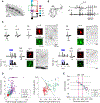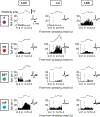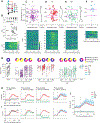Recruitment of GABAergic Interneurons in the Barrel Cortex during Active Tactile Behavior
- PMID: 31466734
- PMCID: PMC6813892
- DOI: 10.1016/j.neuron.2019.07.027
Recruitment of GABAergic Interneurons in the Barrel Cortex during Active Tactile Behavior
Abstract
Neural computation involves diverse types of GABAergic inhibitory interneurons that are integrated with excitatory (E) neurons into precisely structured circuits. To understand how each neuron type shapes sensory representations, we measured firing patterns of defined types of neurons in the barrel cortex while mice performed an active, whisker-dependent object localization task. Touch excited fast-spiking (FS) interneurons at short latency, followed by activation of E neurons and somatostatin-expressing (SST) interneurons. Touch only weakly modulated vasoactive intestinal polypeptide-expressing (VIP) interneurons. Voluntary whisker movement activated FS neurons in the ventral posteromedial nucleus (VPM) target layers, a subset of SST neurons and a majority of VIP neurons. Together, FS neurons track thalamic input, mediating feedforward inhibition. SST neurons monitor local excitation, providing feedback inhibition. VIP neurons are activated by non-sensory inputs, disinhibiting E and FS neurons. Our data reveal rules of recruitment for interneuron types during behavior, providing foundations for understanding computation in cortical microcircuits.
Keywords: FS; GABAergic interneurons; SST; VIP; active touch; barrel cortex; in vivo whole-cell; juxtacellular; movement; opto-tagging.
Copyright © 2019 Elsevier Inc. All rights reserved.
Conflict of interest statement
DECLARATION OF INTERESTS
The authors declare no competing interests.
Figures







Comment in
-
Dynamics of Neuronal Activity in the Cortical Column during Behavior: Both Neuron Type and Layers Matter.Neuron. 2019 Oct 23;104(2):186-188. doi: 10.1016/j.neuron.2019.10.005. Neuron. 2019. PMID: 31647892 Free PMC article.
Similar articles
-
Cell-type-specific recruitment of GABAergic interneurons in the primary somatosensory cortex by long-range inputs.Cell Rep. 2021 Feb 23;34(8):108774. doi: 10.1016/j.celrep.2021.108774. Cell Rep. 2021. PMID: 33626343 Free PMC article.
-
Barrel cortex VIP/ChAT interneurons suppress sensory responses in vivo.PLoS Biol. 2020 Feb 6;18(2):e3000613. doi: 10.1371/journal.pbio.3000613. eCollection 2020 Feb. PLoS Biol. 2020. PMID: 32027647 Free PMC article.
-
Characterizing VIP Neurons in the Barrel Cortex of VIPcre/tdTomato Mice Reveals Layer-Specific Differences.Cereb Cortex. 2015 Dec;25(12):4854-68. doi: 10.1093/cercor/bhv202. Epub 2015 Sep 24. Cereb Cortex. 2015. PMID: 26420784 Free PMC article.
-
Inhibitory interneurons and their circuit motifs in the many layers of the barrel cortex.Neuroscience. 2018 Jan 1;368:132-151. doi: 10.1016/j.neuroscience.2017.05.027. Epub 2017 May 18. Neuroscience. 2018. PMID: 28528964 Review.
-
Spike timing and synaptic dynamics at the awake thalamocortical synapse.Prog Brain Res. 2005;149:91-105. doi: 10.1016/S0079-6123(05)49008-1. Prog Brain Res. 2005. PMID: 16226579 Review.
Cited by
-
In Vivo Whole-Cell Patch-Clamp Methods: Recent Technical Progress and Future Perspectives.Sensors (Basel). 2021 Feb 19;21(4):1448. doi: 10.3390/s21041448. Sensors (Basel). 2021. PMID: 33669656 Free PMC article. Review.
-
Call for a more balanced approach to understanding orbital frontal cortex function.Behav Neurosci. 2021 Apr;135(2):255-266. doi: 10.1037/bne0000450. Behav Neurosci. 2021. PMID: 34060878 Free PMC article.
-
Dynamics of Neuronal Activity in the Cortical Column during Behavior: Both Neuron Type and Layers Matter.Neuron. 2019 Oct 23;104(2):186-188. doi: 10.1016/j.neuron.2019.10.005. Neuron. 2019. PMID: 31647892 Free PMC article.
-
Pathways for Memory, Cognition and Emotional Context: Hippocampal, Subgenual Area 25, and Amygdalar Axons Show Unique Interactions in the Primate Thalamic Reuniens Nucleus.J Neurosci. 2022 Feb 9;42(6):1068-1089. doi: 10.1523/JNEUROSCI.1724-21.2021. Epub 2021 Dec 13. J Neurosci. 2022. PMID: 34903572 Free PMC article.
-
Cholinergic and noradrenergic axonal activity contains a behavioral-state signal that is coordinated across the dorsal cortex.Elife. 2023 Apr 27;12:e81826. doi: 10.7554/eLife.81826. Elife. 2023. PMID: 37102362 Free PMC article.
References
-
- Agmon A, and Connors BW (1991). Thalamocortical responses of mouse somatosensory (barrel) cortexin vitro. Neuroscience 41, 365–379. - PubMed
-
- Armstrong-James M, Fox K, and Das-Gupta A (1992). Flow of excitation within rat barrel cortex on striking a single vibrissa. J. Neurophysiol 68, 1345–1358. - PubMed
-
- Beierlein M, Gibson JR, and Connors BW (2003). Two dynamically distinct inhibitory networks in layer 4 of the neocortex. J. Neurophysiol 90, 2987–3000. - PubMed
Publication types
MeSH terms
Substances
Grants and funding
LinkOut - more resources
Full Text Sources
Molecular Biology Databases

